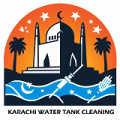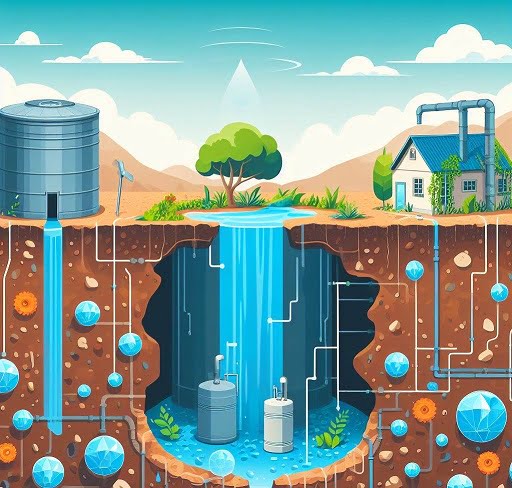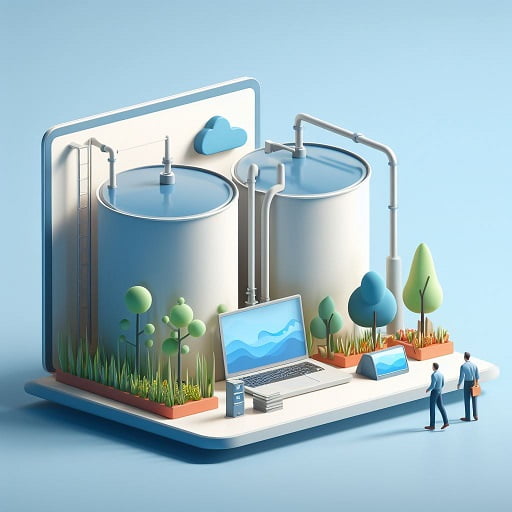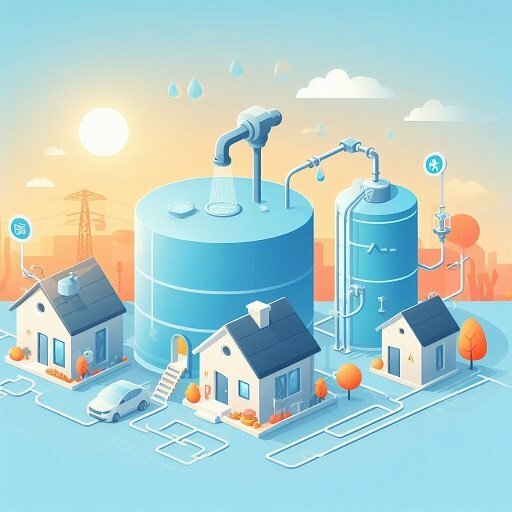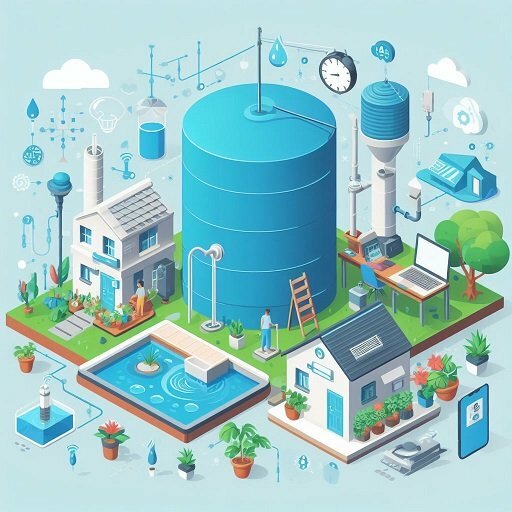Water is essential for life, but it is also a scarce and precious resource in many parts of the world. Karachi, the largest city and economic hub of Pakistan is facing a severe water crisis due to rapid population growth, urbanization, climate change, and mismanagement of water resources. According to a report by the World Bank, Karachi needs about 1,200 million gallons per day (MGD) of water, but it only receives about 550 MGD from various sources, leaving a huge gap of 650 MGD. This means that many residents and businesses in Karachi do not have access to a reliable and safe water supply, which affects their health, hygiene, quality of life, and productivity.
One of the ways to cope with the water scarcity in Karachi is to store water in underground tanks. Underground water tanks are storage containers that are buried below the ground level and connected to pipes or pumps that deliver water to the surface. Underground water tanks can be made of different materials, such as concrete, steel, plastic, or fiberglass, depending on the size, shape, capacity, and durability required. Underground water tanks can be used for various purposes, such as domestic use, irrigation, fire fighting, industrial processes, or emergency backup.
The purpose of this article is to explore the pros and cons of underground water tanks for homes and businesses in Karachi. By weighing the advantages and disadvantages of underground water tanks, we can help you decide whether they are suitable for your needs and preferences.
Pros of Underground Water Tanks
Underground water tanks have several benefits that make them attractive for water storage in Karachi. Some of the main pros of underground water tanks are:
Consistent Water Supply
One of the biggest advantages of underground water tanks is that they provide a consistent and uninterrupted water supply. By storing water in underground tanks, you can reduce your dependence on external sources, such as municipal supply, boreholes, or tankers, which are often unreliable, insufficient, or expensive in Karachi. You can also avoid the problems of low pressure, fluctuating flow, or frequent disruptions that affect the surface water supply systems. With underground water tanks, you can have access to water whenever you need it, without worrying about shortages or interruptions.
Space Efficiency
Another benefit of underground water tanks is that they are space-efficient. Since they are buried below the ground level, they do not occupy any valuable space on your property that could be used for other purposes. This is especially important in Karachi, where land is scarce and expensive, and where many homes and businesses have limited space available for construction or expansion. Underground water tanks also do not affect the aesthetics or appearance of your property, as they are hidden from view and do not create any visual clutter or obstruction.
Environmental Benefits
Underground water tanks also have some environmental benefits that contribute to water conservation and energy efficiency. By storing water in underground tanks, you can reduce the amount of water loss that occurs due to evaporation or leakage from surface storage systems. Evaporation is a significant factor that reduces the availability of water in arid and semi-arid regions like Karachi. Leakage is another problem that affects many surface water supply systems in Karachi due to poor infrastructure and maintenance. By minimizing water loss from evaporation and leakage, you can save more water for your use and reduce your environmental footprint.
Underground water tanks also help to save energy by reducing the need for pumping or heating water. Since underground water tanks are insulated by the soil around them, they maintain a stable temperature throughout the year. This means that you do not need to use as much energy to pump or heat water as you would with surface storage systems that are exposed to temperature variations. By saving energy on pumping or heating water, you can lower your electricity bills and reduce your greenhouse gas emissions.
Cons of Underground Water Tanks
Despite their benefits, underground water tanks also have some drawbacks that may limit their suitability for some homes and businesses in Karachi. Some of the main cons of underground water tanks are:
Installation Costs
One of the biggest disadvantages of underground water tanks is that they are costly to install. Installing an underground water tank requires more labor, materials, and equipment than installing a surface storage system. You also need to hire a professional contractor who has the expertise and experience to design and construct an underground water tank according to your specifications and local regulations. The installation cost of an underground water tank depends on various factors, such as the size, shape, capacity, material, location, and soil condition of the tank. According to some estimates, the installation cost of an underground water tank can range from PKR 50,000 to PKR 500,000 or more.
Construction Challenges
Another drawback of underground water tanks is that they pose some construction challenges that may complicate or delay the installation process. One of the main challenges is the soil condition of the site where you want to install the tank. The soil condition affects the stability, durability, and safety of the tank, as well as the ease and cost of excavation and backfilling. You need to conduct a soil test before installing an underground water tank to determine the type, texture, density, moisture, and bearing capacity of the soil. Some types of soil, such as clay, sand, or rock, may require special treatment or reinforcement to support the weight and pressure of the tank.
Another challenge is the access and excavation of the site where you want to install the tank. You need to have enough space and clearance to dig a hole that is large enough to accommodate the tank and its accessories. You also need to have a suitable method and equipment to transport and lower the tank into the hole without damaging it or causing any accidents. Depending on the size and location of the tank, you may need to use a crane, a truck, or a tractor to move and place the tank. Access and excavation can be difficult or impossible in some areas of Karachi, such as congested streets, narrow alleys, or hilly terrains.
Water Quality Concerns
Underground water tanks also have some water quality concerns that may affect the health and safety of the users. One of the main concerns is the risk of contamination from external sources, such as surface runoff, sewage, chemicals, or pollutants. Contamination can occur due to cracks or leaks in the tank or pipes, improper sealing or venting of the tank, or inadequate drainage or filtration of the surrounding soil. Contaminated water can cause various diseases and infections, such as diarrhea, typhoid, cholera, hepatitis, or dysentery.
Another concern is the need for water treatment before using the water from underground tanks. Water treatment is necessary to remove any impurities or pathogens that may be present in the water due to contamination or natural processes. Water treatment can involve various methods, such as boiling, chlorination, filtration, or reverse osmosis. Water treatment can be costly and time-consuming, and it may also affect the taste and odor of the water.
Suitable Locations for Underground Water Tanks
Underground water tanks are not suitable for every location in Karachi. Some locations may have more advantages or disadvantages than others depending on various factors, such as water demand, availability of space, soil condition, and climate. Some of the suitable locations for underground water tanks are:
Residential Areas
Underground water tanks can be useful for residential areas in Karachi, especially for houses that have limited space or high water demand. Underground water tanks can provide a consistent and reliable water supply for domestic use, such as drinking, cooking, washing, or gardening. Underground water tanks can also improve the aesthetics and value of your property by eliminating the need for unsightly surface tanks or pipes. However, underground water tanks can also be costly and challenging to install and maintain in residential areas. You need to consider the installation cost, construction challenges, and water quality concerns before installing an underground water tank in your home.
Commercial and Industrial Areas
Underground water tanks can also be beneficial for commercial and industrial areas in Karachi, especially for businesses that have high water demand or specific water quality requirements. Underground water tanks can provide a consistent and uninterrupted water supply for various purposes, such as manufacturing processes, cooling systems, or firefighting. Underground water tanks can also save space and energy by reducing the need for surface storage systems or pumping systems. However, underground water tanks can also be expensive and complex to install and maintain in commercial and industrial areas. You need to consider the installation cost, construction challenges, and legal and regulatory considerations before installing an underground water tank in your business.
Institutional Settings
Underground water tanks can also be helpful for institutional settings in Karachi, such as schools, hospitals, or mosques. Underground water tanks can provide a consistent and safe water supply for various needs, such as sanitation, hygiene, or worship. Underground water tanks can also enhance the environmental performance and social responsibility of your institution by reducing water loss and energy consumption. However, underground water tanks can also be difficult and risky to install and maintain in institutional settings. You need to consider the installation cost, construction challenges, and water quality concerns before installing an underground water tank.
Considerations for Karachi’s Climate
Karachi has a hot and arid climate, with high temperatures and low rainfall throughout the year. The average annual temperature is 26.8°C, and the average annual rainfall is 194.9 mm. The climate of Karachi affects the suitability and performance of underground water tanks in several ways. Some of the considerations for Karachi’s climate are:
- Evaporation: Evaporation is a process that reduces the amount of water available in surface storage systems. Evaporation is influenced by factors such as temperature, humidity, wind speed, and solar radiation. Karachi has a high evaporation rate due to its high temperature, low humidity, and strong wind. According to a study by the Pakistan Meteorological Department, the average annual evaporation rate in Karachi is 2,500 mm, which is more than 12 times the average annual rainfall. This means that surface water storage systems in Karachi lose a lot of water due to evaporation, which reduces their efficiency and reliability. Underground water tanks can prevent or minimize evaporation by storing water below the ground level, where it is insulated from the atmospheric conditions.
- Salinity: Salinity is a measure of the amount of dissolved salts in water. Salinity affects the quality and usability of water for various purposes. Salinity can be influenced by factors such as rainfall, runoff, groundwater, seawater intrusion, and human activities. Karachi has a high salinity problem due to its low rainfall, high evaporation, coastal location, and overexploitation of groundwater. According to a report by the Pakistan Council of Research in Water Resources, the average salinity level in Karachi’s groundwater is 5,000 ppm, which is 10 times higher than the World Health Organization’s standard of 500 ppm for drinking water. This means that most of the groundwater in Karachi is unfit for human consumption or irrigation without proper treatment. Underground water tanks can reduce or avoid salinity by storing rainwater or treated water that has low or no salt content.
- Flooding: Flooding is a phenomenon that occurs when water overflows its normal boundaries and covers land that is usually dry. Flooding affects the quantity and quality of water available for storage and use. Flooding can be caused by factors such as heavy rainfall, storm surges, drainage problems, or human interference. Karachi has a high risk of flooding due to its erratic and intense rainfall patterns, low-lying topography, poor drainage system, and rapid urbanization. According to a report by the United Nations Development Programme, Karachi experienced 12 major floods between 1977 and 2017, which caused significant damage to life and property. Flooding can damage or destroy surface water storage systems by washing them away or filling them with debris or contaminated water. Underground water tanks can protect or mitigate flooding by storing water below the ground level, where it is less likely to be affected by surface runoff or inundation.
Tips for Proper Maintenance
Underground water tanks require proper maintenance to ensure their functionality and durability. Proper maintenance can also prevent or reduce the problems associated with underground water tanks, such as contamination, leakage, or corrosion. Some of the tips for proper maintenance are:
Inspection and Cleaning
You should inspect and clean your underground water tank regularly to remove any dirt, sediment, or debris that may accumulate in the tank or pipes over time. Inspection and cleaning can also help you detect any cracks, leaks, or damages that may affect the performance or safety of your tank. You should inspect your tank at least once a year, and clean it at least once every two or three years, depending on the quality and quantity of water you store in it. You can hire a professional service provider who has the equipment and expertise to inspect and clean your tank safely and efficiently.
Pest Control Measures
You should take pest control measures to prevent any insects, rodents, or animals from entering or nesting in your underground water tank or pipes. Pest control measures can also prevent any diseases or infections that may be transmitted by these pests to you or your water supply. You should seal any openings or gaps in your tank or pipes that may allow pests to enter or exit your tank. You should also install screens or filters on your tank vents, inlets, or outlets that may prevent pests from entering or exiting your tank through these openings.
Waterproofing and Leak Repairs
You should waterproof and repair any leaks in your underground water tank or pipes that may cause water loss or contamination. Waterproofing and leak repairs can also extend the lifespan and efficiency of your tank by preventing corrosion or deterioration of your tank material or structure. You should use appropriate materials and methods to waterproof and repair your tank or pipes according to their type, size, and condition. You should also monitor your water level and pressure regularly to detect any signs of leakage or malfunction in your tank or pipes.
Legal and Regulatory Considerations
Underground water tanks are subject to legal and regulatory considerations that may affect their installation and operation. Legal and regulatory considerations can also protect your rights and responsibilities as a water user and a property owner. Some of the legal and regulatory considerations are:
Permits and Approvals
You need to obtain permits and approvals from the relevant authorities before installing an underground water tank on your property. Permits and approvals are necessary to ensure that your tank meets the standards and specifications for safety, quality, and design. Permits and approvals can also prevent any conflicts or disputes with your neighbors, utility providers, or government agencies regarding your water use or property rights. You need to consult with the local municipal corporation, water board, building control authority, environmental protection agency, and other relevant authorities to obtain the required permits and approvals for your tank.
Compliance with Local Regulations
You need to comply with local regulations that govern the installation and operation of underground water tanks on your property. Local regulations are intended to regulate the water use and management in your area to ensure its sustainability and equity. Local regulations can also protect the public health and safety by preventing any hazards or nuisances that may arise from your tank. You need to follow the local regulations regarding the size, shape, capacity, location, material, construction, maintenance, and disposal of your tank. You also need to follow the local regulations regarding the source, quality, quantity, and purpose of the water you store in your tank.
Conclusion
Underground water tanks are a viable option for water storage in Karachi, where water scarcity is a serious and persistent problem. Underground water tanks have several pros, such as consistent water supply, space efficiency, and environmental benefits. However, underground water tanks also have some cons, such as installation costs, construction challenges, and water quality concerns. Therefore, you need to consider the pros and cons of underground water tanks before choosing them for your home or business in Karachi. You also need to consider the suitable locations, the proper maintenance, and the legal and regulatory considerations for underground water tanks in Karachi. By doing so, you can make an informed and responsible decision that can help you achieve sustainable water management in Karachi.
References
- World Bank (2018). Karachi Water Services: Turning Around an Urban Crisis. Retrieved from https://openknowledge.worldbank.org/handle/10986/31018
- Pakistan Meteorological Department (2019). Evaporation Data of Pakistan (1971-2010). Retrieved from http://www.pmd.gov.pk/rnd/rnd_files/vol9_issue16/2_Evaporation%20Data%20of%20Pakistan.pdf
- Pakistan Council of Research in Water Resources (2017). Water Quality Status in Pakistan (2015-16). Retrieved from https://pcrwr.gov.pk/wp-content/uploads/2018/10/WQ-Status-in-Pakistan-2015-16.pdf
- United Nations Development Programme (2018). Floods in Karachi: A City Drowning in its Own Excreta. Retrieved from https://www.pk.undp.org/content/pakistan/en/home/blog/2018/floods-in-karachi–a-city-drowning-in-its-own-excreta.html
